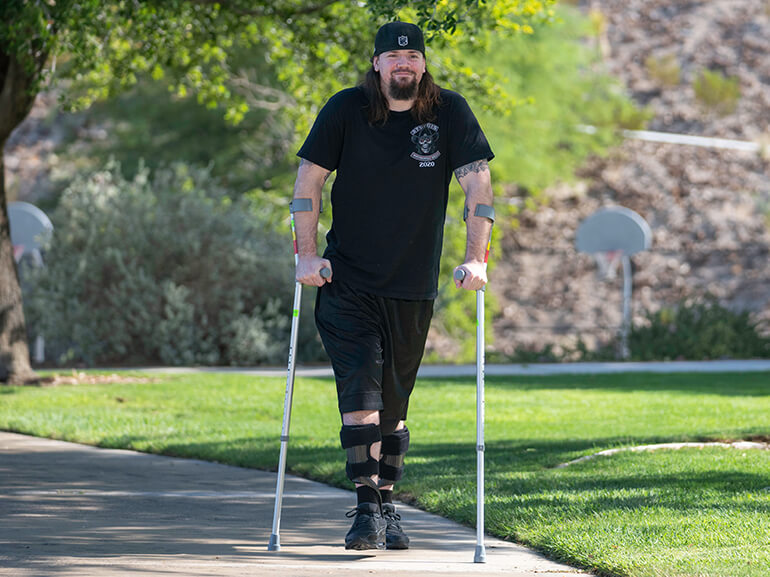Logan's Story

Logan Combs, 31, is a musician who enjoys carpentry, hiking, camping and riding his motorcycle. Logan is from Henderson, Nevada but living in Montana when he experienced a life-changing injury. He was building a house when a wall fell in, folding him in half at the waist. “When I saw the wall coming at me I thought I was going to die. The amount of fear that overcame my body was cold and numbing and seemed to suck the life from my body.”
Logan was rushed by ambulance to the local hospital, diagnosed with a spinal cord injury and underwent fusion surgery on his spine. He spent six weeks in the hospital before being discharged to Dignity Health Rehabilitation Hospital for additional healing and recovery.
When Logan arrived for inpatient rehabilitation, he was unable to independently walk, stand, go up steps or transfer from one surface to another. He had to learn how to do everything from a wheelchair level.
Logan set goals for himself, saying, “I want to be able to walk.” A secondary goal was to ride his motorcycle again. His team began a therapy regimen consisting of both physical and occupational therapy to see if they could get him there.
During his physical therapy sessions, a treatment mat was the most used area for exercises in various positions including tall kneeling, quadruped (hand and knees), supine (on back) and prone (on stomach). As Logan got stronger, he progressed to standing tasks and therapists reduced his arm support and placed more demands on his legs. Logan did a lot of standing in the LiteGait harness, a body weight support system, for safety because he wasn’t able to stand without arm support and his legs would often collapse.
As his strength increased, Logan also performed mini squats and walking using the LiteGait. At 12 weeks post-surgery, Logan began using the Lokomat, a robot-assisted gait-training device where patients are supported in a harness above a treadmill while the robotic device moves their legs through a "normal" gait cycle. Therapists also used electric stimulation to help “retrain” Logan’s legs how to move again. In time, Logan progressed to a walker, and after another two months, he was using forearm crutches. The transition to crutches was monumental because the next step will be using one crutch, allowing him to carry an object with one of his hands.
In occupational therapy, Logan performed exercises and activities to help improve balance and regain independence in doing everyday tasks. He played ping-pong using the Wii for standing balance and tolerance. He also practiced daily living activities to prepare for his return home. Near the end of his stay, therapists put weights in his backpack and had him walk on the external grounds of the hospital to simulate community mobility and introduce the idea of hiking.
After four months at Dignity Health Rehabilitation Hospital, Logan discharged able to walk with forearm crutches and independently care for himself. He was looking forward to getting back to society, having his own refrigerator and continuing to gain strength and mobility with outpatient therapy at Dignity Health Physical Therapy.
When asked about his time at Dignity Rehabilitation Hospital, Logan said, “It was intense, but enjoyable. My therapists gave me great care and showed determination to improve my daily progress.